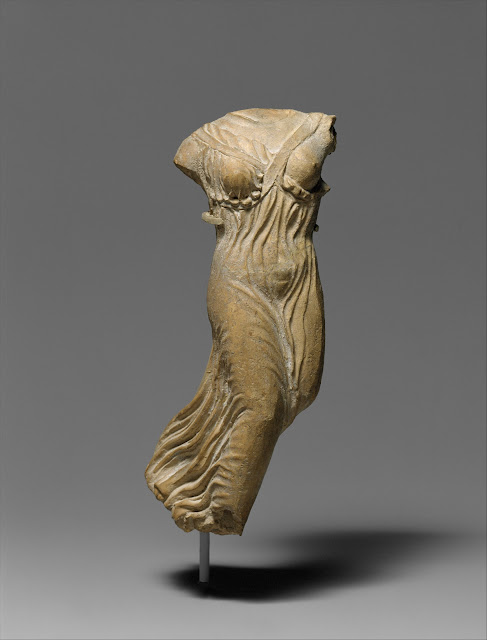 |
| Anonymous Greek sculptor Nike ca. 500-475 BC terracotta statuette Metropolitan Museum of Art, New York |
"Three-dimensional representations of Nike, the winged goddess who brought victory in both battle and athletic contests, usually attempted to evoke flight or the moment of alighting. This flying figure once had wings attached to the slots in the back."
 |
| Anonymous Greek sculptor working in South Italy Relief of Reclining Youth (Banqueter) 5th century BC terracotta Metropolitan Museum of Art, New York |
 |
| Anonymous Greek sculptor Lekythos in form of flying Eros ca. 400-350 BC terracotta Metropolitan Museum of Art, New York |
"Although vases in figural form were known in Greek art since early Archaic times, during the fourth century BC a particularly elaborate combination of vase and terracotta developed. . . . The figure holds an incense burner."
 |
| Anonymous Greek sculptor Draped Woman ca. 315-285 BC (Hellenistic) terracotta statuette Metropolitan Museum of Art, New York |
 |
| Giovanni della Robbia Classical Female Head ca. 1520-25 glazed terracotta Victoria & Albert Museum |
 |
| Anonymous Italian sculptor Michelangelo's Hand ca. 1580 terracotta Victoria & Albert Museum |
 |
| Anonymous Italian sculptor Michelangelo's Hand ca. 1580 terracotta Victoria & Albert Museum |
"This terracotta model of a hand has been long known as Michelangelo's Hand because it was formerly ascribed to him. A similar model of a hand was recorded in a room near the Cappella dei Principi in San Lorenzo, Florence, where Michelangelo carved his famous marble tomb figures for the Medici, but that object had disappeared by 1813. It is possible that this is the same model."
 |
| Anonymous Italian sculptor Reduced copy of Michelangelo's Dawn 16th century terracotta Victoria & Albert Museum |
 |
| Giuseppe Sanmartino St Vincent Ferrer 1750 terracotta statuette Metropolitan Museum of Art, New York |
"Saint Vincent Ferrer (1350-1419), the Spanish Dominican, was frequently known as "the Angel of Judgement," reflecting his powerful preaching of repentance and penance that converted tens of thousands of non-believers within and outside Spain. Vincent's fervor transcended so many language barriers that he was believed to posses the gift of tongues, symbolized by the flame emerging from his tonsured pate."
 |
| Thomas Banks Achilles arming ca. 1777 terracotta model Victoria & Albert Museum |
"Thomas Banks (1735-1805) was apprenticed to a London mason, but also spent time working alongside the sculptor Peter Scheemakers (1691-1781). He enrolled in life classes held at the St Martin's Lane Academy, and later at the Royal Academy Schools. In 1772 he became the first sculptor to win the Royal Academy's three-year travelling stipend and went with his wife to Rome, where he eventually spent seven years. He specialised in ideal works, most of which were executed in Rome for British patrons, although he continued to produce similar works after his return to London. He was made a Royal Academician in 1786. Banks was one of the most original British Neo-classical sculptors. . . . Achilles, the doomed hero of Homer's Greek epic The Iliad, seems to have been a particular favourite of the artist's. When it was acquired by the Victoria & Albert in 1955, this terracotta had been broken into many pieces. It was conserved shortly after its acquisition."
 |
| Anonymous Italian sculptor working in Naples Cherub with outstretched arms ca. 1750-1850 polychromed terracotta Metropolitan Museum of Art, New York |
 |
| Anonymous Italian sculptor Jonah ca. 1825-50 terracotta statuette Victoria & Albert Museum |
"Purchased in 1854 in Florence from the Gherardini Collection, an important collection of sketch-models by Michelangelo, Giambologna and their followers. This piece was then considered to be a sketch-model by Raphael for the figure of Jonah carved by Lorenzetti for the Chigi Chapel in Santa Maria del Popolo, Rome. It was later connected with the figure of Narcissus by Benvenuto Cellini. However, the results of thermo-luminescence analysis to determine the age of the piece suggest that it probably dates from about 1825-50. Such technical data is not entirely reliable, but the model does not relate directly to either of the suggested sculptures."
 |
| Anonymous French sculptor Hercules ca. 1850 terracotta sketch-model Victoria & Albert Museum |
 |
| Jean-Baptiste Carpeaux Impression of Amélie de Montfort ca. 1867-69 terracotta Metropolitan Museum of Art, New York |
"Rapidly sketched, the model delivers the basics of the master's intense attachment to his fiancée, a young aristocrat, first glimpsed at a ball. The marriage took place in 1869 but soon soured owing to Carpeaux's morbid, irrational suspicions of infidelity on his wife's part."
– texts based on curator's notes at the respective museums